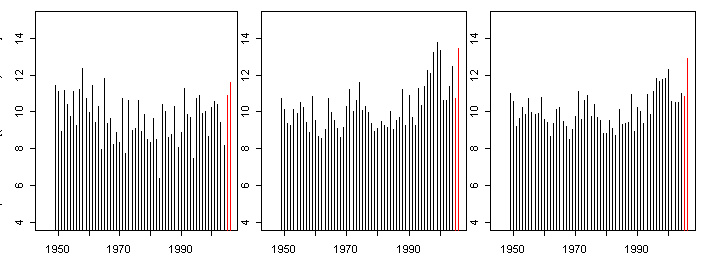Emanuel 2005 stated:
The annual average storm peak wind speed summed over the North Atlantic and eastern and western North Pacific has also increased during this period, by about 50%.
Once again, I can’t reproduce this result. Here are my calculations.
First, here are my calculations of annual average storm peak wind speed from the archived data, using only storms with peak wind greater than 18 m/sec (applying definition in Landsea’s Comment on Emanuel.

Peak Wind . Left- Atlantic; center – W Pacific; right – Total
The next figure shows attempts to fit linear trends to the data; the blue segments correspond to ones that I experimented with in trying to make sense of the accumulated annual duration data.

Using fitted data, the increase from 1949 to 2004 is 11% (not 50%); if you take the year 2004 over year 1949, you get 19%; if you take the 5-year mean for 2000-2004 over 1946-1950, you get 7%. How did Emanuel get 50%? I have no idea, but I have no idea how he got 50% for the supposed increase in accumulated annual duration.
Script is here




8 Comments
This is from Emanuel’s home page updated in January 2006.
http://wind.mit.edu/~emanuel/anthro2.htm
I suppose its too late ask how you measure “annual average storm peak wind speed” across two ocean basins and whether this means anything?
For example, do you measure wind speed over a period of several days and take the average or the root mean square or what? And how did they measure these speeds in the 1950s? Is it like today?
Like the concept of “global mean temperature” when you drill down and ask what these ad hoc statistics mean, you find that its a lot less than you think.
Re# 1: I scratch my head over that. Energy is a function of the square of windspeed (that’s the definition commonly used), so a 15% increase in windspeed should result in a 32% increase in storm energy. But is his “windspeed” the storm max windspeed or the average of each quarter-day, or just what? I don’t know. I may be overlooking the obvious.
Also, my calculator says that if A increases by 15% and B increases by 60%, then AB increases by 84%. I’m not suggesting anything about his method other than that I can’t figure it out. Been a long day for me, building a deck in my backyard, need a beer and chicken fajitas, then maybe it will become clear!
David #3: The energy in wind is a cubic function of the windspeed. The kinetic energy in a mass of air is a square function, but the amount of air passing a given point is proportional to the windspeed (linear), so the wind energy is the product of these — a cubic. Whether this is the best metric for a hurricane or not is another issue.
Thanks. So this is proportional to PDI.
Do you figure that when Emanuel says, “15% increase in wind speed”, he actually means “15% increase in PDI due to increased windspeed”?
The graphs above do not look like they support a 50 percent increase in ‘average peak wind speed’ over the time period, and I am at a loss to see how someone could make such a claim from the data as it stands.
On the other hand, if Emanuel was actually referring to wind power inferred by cubing the windspeed he might come closer to making such a claim from the data, as the combined graph does have a small rising trend that would be amplified considerably by cubing the wind.
Perhaps you could redraw the three graphs with wind speed cubed to see if this is what he has done?
#3,4,6: Just to clarify. If windspeed cubed is being used then the discussion is about a wind energy flux, that is, energy/time/area. This is only an appropriate metric if energy transport is under consideration. If the issue is just pure energy then velocity squared should be used.
So the question is: do you take the arithmetic mean or the geometric mean to get to average peak wind speed?